What a year it’s been with so many things to worry about! From Spotted Lanternflies to Murder Hornets, things outdoors lately also seem kind of scary! Unfortunately, there’s a garden invader many of us have, but many do not know about- a creature worming its way through North America!
I’ve lived and gardened on my property for over 25 years. When we first moved in, the house had been empty for a long time, and the yard was void of much, except for overgrown grass and a few flower beds near the foundation. The yard was a blank canvas; I feel I know every inch of earth here. We’ve built flower beds and gardens that I “baby” each season.
Like most gardeners, whenever I’d see an earthworm, I’d get excited, thinking my soil must be really healthy. Most earthworms are non-native, brought here from somewhere else at one point. There are 6,000 species of worms worldwide, with three main types: flatworms, roundworms, and segmented worms. Earthworms have no eyes, but they sense light, mostly at their anterior sections. An earthworm will repel itself from light, becoming paralyzed if exposed too long, within an hour. Cold-blooded they breathe through their skin. If an earthworm‘s skin dries out, it dies. They eat their weight each day, and “process” soil, by burying subsoil closer to the surface to mix with the topsoil; their sticky slime secretions hold clusters of soil particles together, and contain nitrogen. Earthworms are both male and female; their eggs are deposited in “cocoons”, smaller than grains of rice. The clitellum, which is the band or “saddle” you see near the anterior section of the worm, makes the cocoons for the eggs. One acre of land can contain one million earthworms! Worms live an average of 1 – 2 years, up to eight years, and only grow so long depending on age and species.
Jumping Snake Worms, on the other hand are an invisible, negative invasive species of earthworm, introduced from Asia, probably through imported mulch, compost, and potted plants. A fast-maturing worm, they become adults within 60 days, with prolific reproduction. They are parthenogenetic, meaning eggs can hatch without being fertilized.
They really have no natural enemies, and populations vary year to year, with population explosions every few years. Birds don’t generally eat them, most likely due to the bad-tasting yellow secretion they have as a defense. I have seen wild robins toss them aside and my chickens, who will eat anything, will NOT touch them. For the songbirds that do eat them, it’s like eating “junk food”, not being nutrient enough as native caterpillars. Fish don’t like them, either.
Invading areas where earthworms haven’t been before, they’re a threat to forests, yards and gardens. They over-process the soil, churning it so fast and superficially on the surface, that they deplete the soil and plants around them of needed nutrients. There are 51 species of Jumping Snake Worm in the US. In my area of New England, we find three different but closely-related species, all usually found together (a strange trait), but the Amynthas agrestis is the most common here.
These worms are often mistaken for the common European earthworm. Jumping Snake worms move fast, with thrashing and slithery movements. Large moving adults look like snakes, and can be up to eight inches long. They jump to move, while other earthworms use their segments to “inch” along. The “saddle” on the Jumping Snake worm is often milky in color, smooth to the body of the worm, and goes all the way around. On other species, the “saddle” is raised and pink, not going around the entire perimeter of the worm. The Jumping Snake worm ranges in color from gray to brown, with glossy skin that has a (pretty) sheen to it.
They stick mostly just under the surface, attaching themselves to plant roots (Often, they’re introduced to an area through worm-infected transplants).
They were first noticed in the US under DC cherry trees in 1912, and in greenhouses and NYC zoos in the 1940s. Commonly they are also called names like Asian Jumping Worms, Jersey or Alabama Wigglers, Georgia Jumpers, or Crazy Worms.
These buggers are hard to photograph because of the thrashing they do as soon as they are disturbed. (The worm above is a juvenile worm, photographed in late June). In New England, we see them mostly from April to September.
Most gardeners see the over-processed soil before the worms themselves, when noticing dry, crumbly soil resembling coffee grounds or cookie crumbs. This process creates erosion because the chunks won’t hold water. This causes root desiccation and unstable rooting in trees and plants.
In grassy yards, worm casing piles are often mistaken for ant beds. Jumping Snake worms disturb the plants, sucking nutrients from the roots.
When Jumping Snake worms attack an area, they displace natural and native species, such as good earthworms like Canadian Nightcrawlers. The invasive worms also cause extinctions of native plant species.
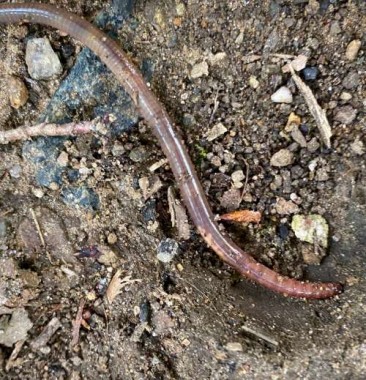
An example of a “good” earthworm…notice the raised saddle. It moved slowly by “inching” along as opposed to slithering.
Unfortunately, poison ivy is a plant example resistant to Jumping Snake worms. Many important native plants are affected, which furthers the growth of invasive plants. The worms also cause stress to native fungi that are necessary to plants. It’s an awful circle!
Our natural forests have a deep layer of slowly decomposing leaves and organic matter called “duff”. When the interloping earthworms invade forests, they quickly eat up the duff, and the soil becomes more compact than aerated. As the duff disappears, so do native forest plants, insects and small animals such as salamanders.
Birds are also impacted, because their food and shelters are affected. Landscaping, parks, golf courses, and yards are affected. Instances have occurred where entire yards were destroyed by the worms’ over-processing.
Jumping Snake worms became my own personal enemy when they attacked my property to the point of noticeable, visible damage. I really love my Hostas, a part of my gardens for decades. Hostas seem very vulnerable to the worms. This is a photo of my largest hosta bed in the summer of 2017.
The following summer, the hostas had all but disappeared, barely returning.
(The hostas shown are ones I planted from seed. The mulch was new, and not the source of the worms. I believe that they were introduced to my yard originally from infected mulch). The bleeding heart was unaffected. Poisonous to animals and humans, it could be why the worms didn’t mess with it. Hostas in other parts of the yard were unaffected- damage done to this bed was by a Jumping Snake worm swarm, a common behavior.
Presence of the worms was confirmed by the granulated, dry soil piles left behind under the hostas. By the time I noticed it, it was too late.
We also had damage done by an additional swarm to a stone wall and steps on the other side of the property.
Unfortunately, currently, there’s no solid way for a home gardener to get rid these worms, especially organically.
Now, my hostas are back, beautiful and full. What did I do? I hand-picked worms from the surface as best I could,disposing of them in a bucket of vinegar and water. It’s not pretty, time consuming and tedious. It did, however, drastically cut down their numbers. Plain water won’t work, because the Jumping Snake worm can survive in water for long periods.
CAN we do anything to slow their spread? Yes- buy mulch from reliable sources, inspect transplants before planting for evidence of worms, (look at the roots of plants and for evidence of grainy soil), don’t use the worms for compost, (purchase Red Wigglers, instead), and if you notice you have the invasive worms, don’t share your plants.
Don’t despair, gardening is still wonderful! There’s just always something that needs attention. There’s also so much beauty outside, every season. Here are a few examples from this summer in my yard…
Remember to leave me a comment below so I know you stopped by!
Until Next Time…Farmgirl Hugs (still virtually and six feet apart, but the sentiment is there),
Nicole


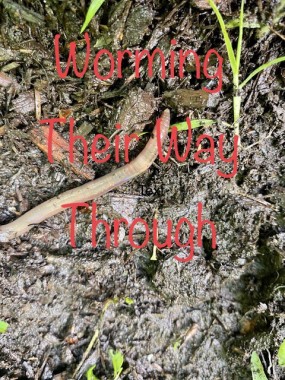
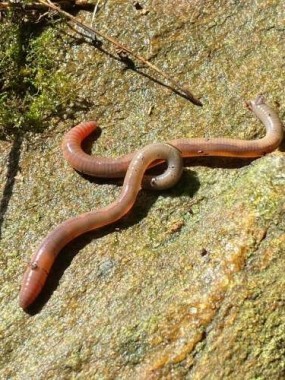
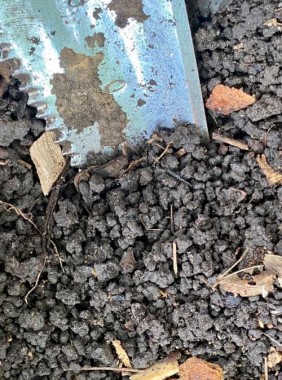
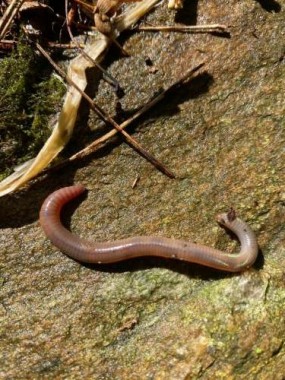
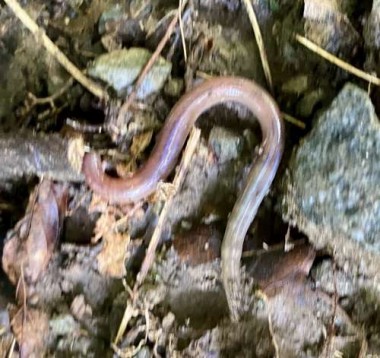
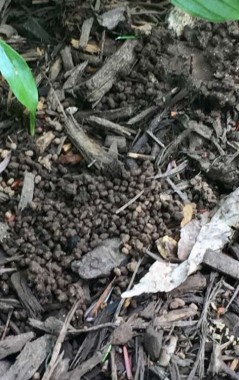
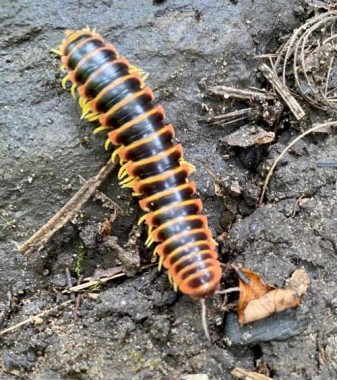
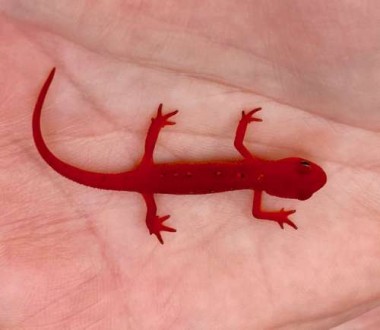
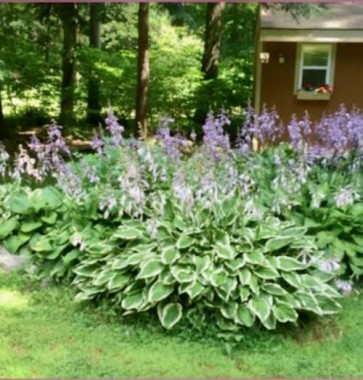
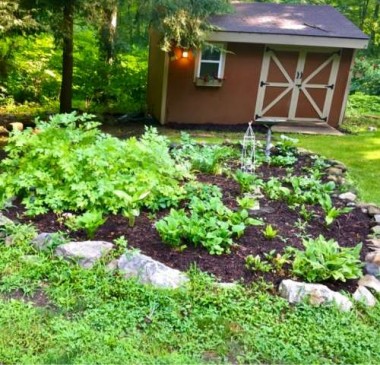
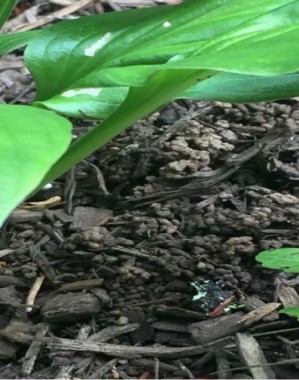
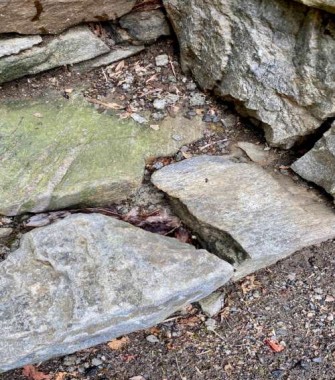
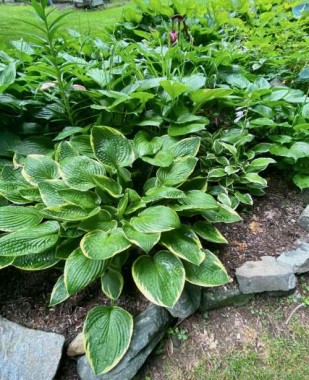
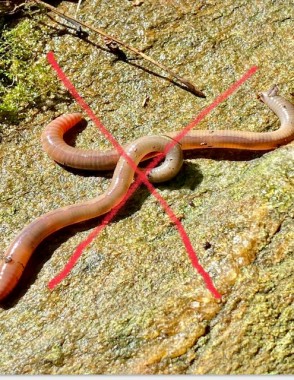
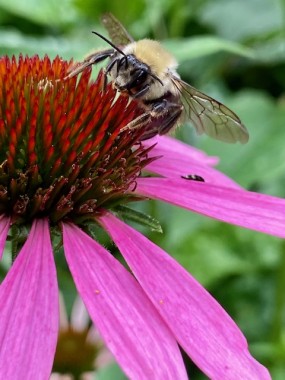
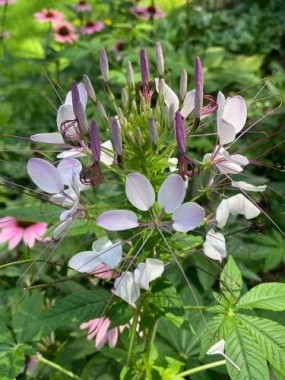
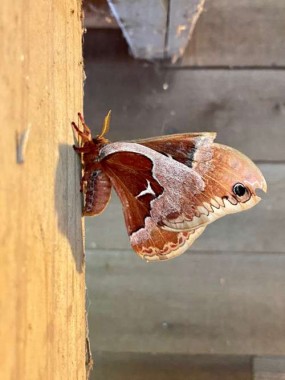
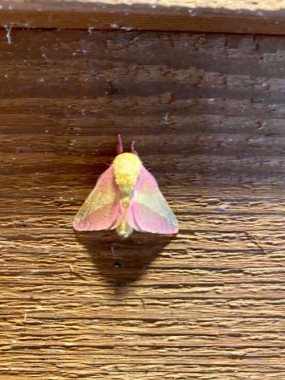
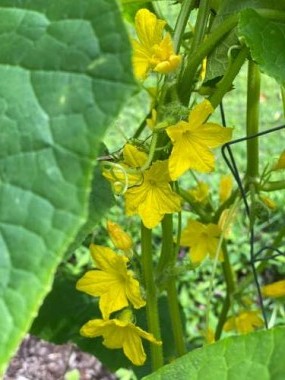
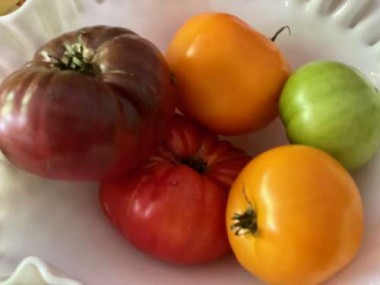









Nicole, what great information. Living in western North Carolina, I fortunately have not so far discovered any of these miserable little creatures, although some “invisible” worms are making a buffet out of my tomato plants at this time. Like you, I love my hostas. In my case, so do the local deer, who graze freely on my 25 + acres. So why, oh why, do they insist on coming up to the absolute edge of my driveway and deck to lunch on my favorite specimens? But hey, I do love my deer as well, and the hostas always come back, so I get to enjoy them briefly every spring.
Hi Suzi, I love seeing the deer, too. I think they are beautiful. I also love seeing the babies in the spring and summer. But they do like to nibble my hostas. Try “Liquid Deer Fence”. Just spray it on and it keeps the deer at bay. I swear by it. Farmgirl Hugs, Nicole
Thanks so much. You are definitely my kind of person!
Suzi
Well thank you, Suzi! Farmgirl Hugs, Nicole
Wow, Nicole, I feel like I just took a mini-course in something that I didn’t even know existed. I really appreciate your write-up!….You may have helped me identify some problems that I could not identify because I didn’t know where to start….Your time and “research notes” are wonderful. I know you are very busy, so I especially appreciate this. Thank you, Mary Frances Rauch, living in central Ohio.
Hi Mary, thank you! One thing I love about gardening is that even if you are a seasoned gardener, gardening for years, there is still always something new to learn. Enjoy the gardening season! Farmgirl Hugs, Nicole
Thanks so much for this valuable information! I will be very diligent in watching out for these buggers.
Hi Bonnie, thank you…they are kind of pretty with the sheen to their skin, but what nasty damage they can do! Thanks for reading and commenting. Farmgirl Hugs, Nicole
Thank you for all this information. I don’t know if we have these worms here but I’ll be checking it out. It could explain the mysterious dying of some of our plants. Or we have yet another invader. Anyway, thanks for the lesson.
Hi Marlene, Thank you! Glad you found this helpful. If you have dying plants with no other obvious reasons, it certainly could be the problem. Farmgirl Hugs, Nicole
How interesting,
I though all earthworms were “good and helpful”
Those snake worms are gross. Thanks for vinegar and water information to dispose of them…
Hi Julie, Right? I thought the same too, but these worms are not good. Farmgirl Hugs, Nicole
Wonderful, informative post, Nicole. I’ve never heard of these worms but I’m on the look-out now! Thanks to your research and photos, I know exactly what I’m looking for and what to do if I spot any.
Hi MaryJane, thank you so much! While they are slow moving, their spread is unfortunately very wide. Good to keep an eye out. Farmgirl Hugs, Nicole
Hi, Nicole. Very interesting post. I haven’t heard of these worms but will definitely be on the lookout for them. I live in Lansing in the upper mountains of North Carolina. We garden a little. We have lots of hostas, but the deer eat them, even close to the house. We are trying to plant things that the deer won’t eat….lol. I enjoyed your post and will be reading some of your older posts. Stay safe and take care. jmp
Hi Joan, have you tried “Liquid Deer Fence”? I swear by it. I buy a gallon jug each year and use it the whole season. It is systemic so the deer won’t eat your hostas. I spray them a bit every couple of weeks. It won’t harm anything, just smells to high Heaven when you spray. It is sold at Home Depot, Tractor Supply and Lowes, and most garden stores. You know when it wears off because the edges of the plant might get a little nibble as the deer test it. Use it until the winter and in the spring when things first start popping up. Thanks so much for stopping by the blog! Farmgirl Hugs, Nicole
O lordy..what will we import next..love your flowers and your education..keeps us on our toes.
Hi Donna, thank you! Farmgirl Hugs, Nicole
Hi Nicole;
Ugh, I hope I never have these creatures in my yard. I like earthworms and nightcrawlers; good for garden and for fishing. Thanks for posting about these though, in case they show up somewhere close by, I can tell people what they are. Too bad there is no easy way to get rid of them. The frost this spring hurt most of my garden plants, the hostas, the tree lily’s and the iris’ were really hurt as they came up and were budding before the frost hit. Hopefully after this fall’s redo, we will have better luck in the spring.
Hi Sandi, I hear ya. Some years in the garden are unfortunately disappointing. There is always next year, yes. It reminds me of an old golf bumper sticker I saw: “I hate golf, I hate golf, nice shot, I love golf”. Thanks for reading and commenting! Farmgirl Hugs, Nicole
Thank you for the pictures! Especially of the worms. We know they are in Wisconsin, and now, thanks to your article and pics, we know what to watch for and what we can do. Thanks! Happy Gardening!
Hi Maria, thanks so much! I am glad you found the article informative! Happy gardening! Farmgirl Hugs, Nicole
So might we be able to rid them of peppermint oil? Peppermint oil kills roaches,spiders, and many more even ants.
Are they in Florida yet? Great content. Right now we have a ton of months. Walk and they are by the thousands cutting the pastures.
Thanks for your answers ahead.
Debra J Price
Hi Debra, I doubt it. I have not found anything on using that for them. So far, the only thing I have heard (and from multiple, reliable sources) is the use of saponins which irritate the skin of the worm. Dry mustard in water is also an irritant. Mix 1 tablespoon to a gallon of water, and spread over an area. The worms will come to the surface and then you can destroy them. Thanks for reading and commenting! Farmgirl Hugs, Nicole
Scary!!! Thank you for giving us the head’s up and what to look for in our soil.
Do they bit humans or animals such as cats and dogs in our personal spaces or wild animals in our forests? If so, what do we do?
Hi Jessica, good question, but no worries! They are harmless to touch and non-toxic. They do not bite. They are a nuisance in the damage that they do to our plants and forestry. Don’t be afraid to pick them up to destroy them such as in the vinegar- just be careful because they can shed their tails and regenerate. Thanks for stopping by the blog! Farmgirl Hugs, Nicole
Good information thanks for sharing
Hi Vivian, you are welcome! Thanks for stopping by the blog! Farmgirl Hugs, Nicole
Wow who knew ?
And frankly I don’t know if I would be able to tell the difference between them and good ole earthworms
Thank you for letting us farm girls know about this serious problem
Have a good summer and good luck all my fellow farm girls with this bad bad worm!
Hi Lisa, The jumping worms thrash about so much that you can’t mistake them. The “good ol’ earthworm” do not thrash about violently like the jumping worms. Also, the jumping worms slither quickly like a snake, other worms inch slowly. Have a good summer, too! Thanks for reading and commenting! Farmgirl Hugs, Nicole
Thank you for this information!!
I have seen these granule hills all over my yards from East Ga. to South West Ga & Then Coastal Carolina but had no idea an invasive worm was leaving the “pile”. Now I will be destroying them. I’ve been laying down weed block fabric topped with cypress mulch to form paths for two days i our 92-95 degree days. I have seen these jumpers as I’ve dug out the dreaded Smilax! The heat index has been 100 to 105 & even 108 lately.
Hi Judy, wow! My mom lives in GA and I know how hot it gets there…it is hard to be doing the work you are doing in that heat. I am glad you found the blog informative! Thanks for reading and commenting! Farmgirl Hugs, Nicole
Thank you so much for this article!!! I will be on the lookout for this creature. I did the same type of control with 1000’s of Japanese Beatles in my yard when I first moved to my “farm”. I now have them under control and have just enough to feed to my ducks. I have not seen this worm, but hope I never do. Would you suggest purchasing bare root plants?
Hi Deborah, You are so welcome…I am glad you enjoyed this post. A bit of advice on the Japanese beetles…(chickens also love them, by the way), do not buy the “beetle bags”, as they can actually be counterproductive and draw the beetles to you. The bags can also hurt the beneficial insects. To answer your question, yes, bare root plants are a good idea, as are plants from seed. This helps keep the worm spread at bay. Thanks for reading and commenting! Farmgirl Hugs, Nicole
Wow, Nicole! Thank you for warning me about the Jumping Snake Worm! My husband and I retired 9 yrs ago and built a house on a country lot that I have been “building” a yard, flower beds, and raised gardens on here in Iowa. A couple yrs ago I was so delighted to see my composting and hard work landscaping paying off by seeing earth worms!
This year, I could not get heirloom tomato transplants or any good tomato transplants so my crop has done poorly. I also ordered special buttercup seeds and the plants were doing so well. But – while gone a week camping (yes, we can camp in Iowa!), cut worms invaded! I was able to slit the stems, remove what worms I could, and buried the stems. So far it has worked! No need for Sevin! Do you know a natural way to help?
We are in desperate need of rain here. My son is a farmer and our corn and soybeans really need the moisture now!
So nice to catch your blog, Nicole! Your photos are beautiful and your advice! Thank you!
Hi Karilyn, Thank you…I am glad you found this post helpful. Iowa has always been on my “bucket travel to” list. I even sent away for the state travel brochure 15 years ago! Someday I hope to go there to visit; it seems so beautiful and the people I have met from there are so nice. As for the cutworms, here is some organic advice I can give you. First, I make little “bases” or “collars” for bottoms of the plants. This works well for tomatoes, cabbage, peppers and cauliflower. Cut the bottom square off of the bottom of a paper milk carton, then cut a slit in one side. Slide the base of the plant into the slit so the base or bottom of the plant near the ground is inside the middle of the square. Second, use coffee grounds or egg shells on the ground around your plants. Bt is organic and can be used in the fight against cutworms, and I also like to use “Surround” , aka organic kaolin clay, mixed with a little water on the plants (use a teat sprayer from the feed store, that way you can spray the undersides). I also plant basil and french marigolds between plants for organic pest management. I hope you all get the rain you need! Thank you so much for reading and commenting! Farmgirl Hugs, Nicole
I have been thinking about these worms a lot, since I read your article. Has anyone tried DE, Diatomaceous Earth? It is used to kill soft bodied insects. They die by a thousand cuts and dehydration.
Hi Deborah, DE can help with cutworms, but I have found no info that it works for jumping worms, unfortunately. I use it quite often at home and it is great in the chicken coop as well. Good question! Farmgirl Hugs, Nicole
Well, I can honestly say I learn something new everyday now that I have read this narrative. Thank you. I had no idea anything of this sort existed. I’ll bet people who don’t garden have never heard of it either. I do garden, but am clueless about this species of critter. lol Thank you. I enjoyed this and will definitely keep an eye open.
Hi Carol, I think I had started to see them a while before I realized what they are. Now I know what to look for before they damage something to the point of no return. I am so happy to have my hostas back! Farmgirl Hugs, Nicole
I never have heard of these worms Nicole. Thank you, very informative information.
Hi Linda, thanks1 Next time I see you I can show you one. Farmgirl Hugs, Nicole
Awesome post! I, too, live in CT, and will be on the lookout. I’ll look around my yard and hope I don’t find evidence of their being here. Thanks so much. I never knew about theses worms and like others, thought great! Worms are good. But apparently not all.
Thanks for an awesome blog and lesson 🙂
Hi Mary Ellen, thank you so much! Unfortunately, they are very concentrated in Connecticut. Keep your eyes open. Thanks for reading and commenting! Farmgirl Hugs, Nicole
Hope the worms don’t get here, in Michigan. Having trouble picking off the Japanese beetles. They are on everything.
Hi Carolyn, Hope you don’t get the worms, either. They are awful. Japanese beetles can be a problem. They grow from grubs in the yard, so if you treat the grubs, you will see less beetles next year (chickens love grubs). If I didn’t mention it before, make sure you do not use those “bag a bug” traps…they actually draw them to your property. Farmgirl Hugs, Nicole
I did not know this about those worms but I’ll pay attention to my flower beds a little closer now. Thanks!
Hi Denise, you are welcome.I pray that you do not get them in your area! Farmgirl Hugs, Nicole
I got those years ago, sold as fishing bait and wondered at the time why they looked different. Not knowing better I but them in my garden, and now I understand why I’ve lost my fruit trees, slowly.
Hi Susan, I am so sorry to hear you have lost your fruit trees. I think I may have gotten some in the garden with this year’s mulch, or the swarm we had has moved. They are really awful creatures. Good luck with your trees, and thank you for reading and commenting. Farmgirl Hugs, Nicole
Before you were born I went fishing in Texas and put worms on my fish hook! Very slimy and gross. I am impressed with so much information about worms! Liked the pretty pictures. Love,
Mother
Hi Mom, I am laughing because I still can not imagine you fishing with worms! They are slimy, but after having an indoor worm garden and raising a child who loved playing with bugs and critters outside, things like this do not gross me out anymore! Not much really does in fact! Glad you liked the post. Watch your yard and garden- these invasives are awful. Love, Nicole
Very informative article. Live the pictures!
Thank you, Debby! Farmgirl Hugs, Nicole
Thanks for the info…I don’t think that I have these in my yard…yet. Because of your info I will be on the lookout. I live in a very, very sandy area of Auburn, ME. The ground is similar to that soil in the Desert of Maine in Freeport…same vein of sand/dirt left by the glaciers.
Hi Deb, Definitely keep an eye out, though they may not be found up there yet. I will have to research. You are very lucky they are not a pest for you – they are awful little creatures. Love that part of Maine! So beautiful! Farmgirl Hugs, Nicole